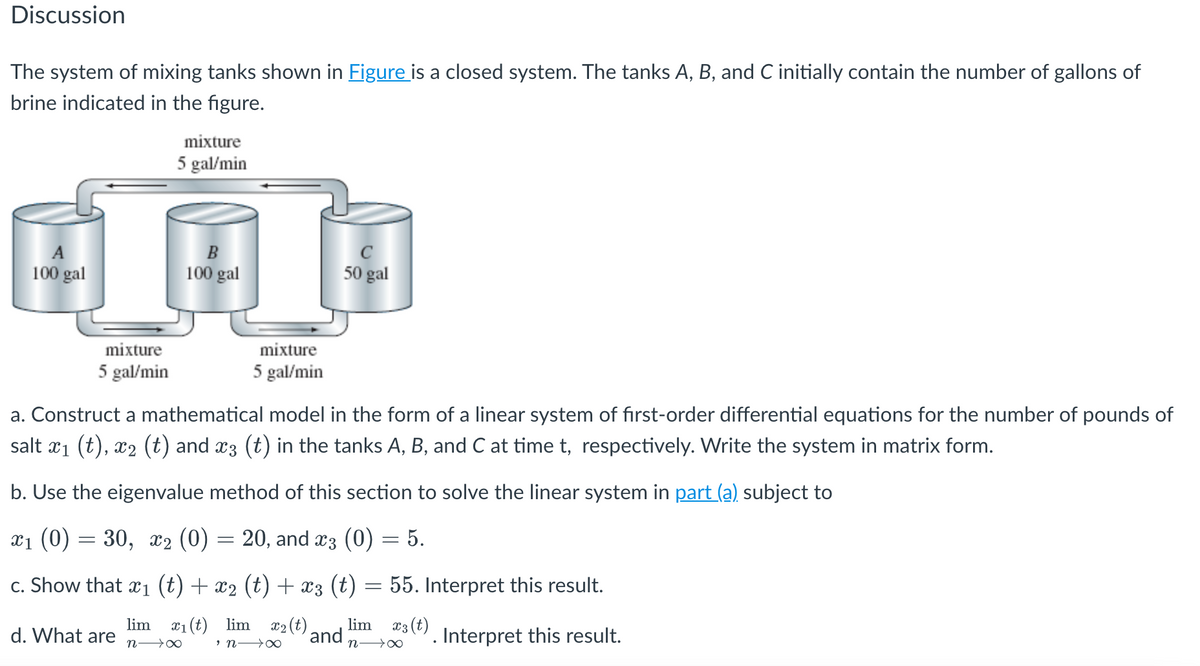The system of mixing tanks shown in Figure is a closed system. The
Functions and Change: A Modeling Approach to College Algebra (MindTap Course List)
6th Edition
ISBN:9781337111348
Author:Bruce Crauder, Benny Evans, Alan Noell
Publisher:Bruce Crauder, Benny Evans, Alan Noell
Chapter3: Straight Lines And Linear Functions
Section3.5: Systems Of Equations
Problem 5SBE: Setting Up System of Equations In Exercises S-3 through S-6, you are asked to write a system of two...
Related questions
Question
Please help with part b) ASAP!

Transcribed Image Text:Discussion
The system of mixing tanks shown in Figure is a closed system. The tanks A, B, and C initially contain the number of gallons of
brine indicated in the figure.
mixture
5 gal/min
B
C
100 gal
100 gal
50 gal
mixture
mixture
5 gal/min
5 gal/min
a. Construct a mathematical model in the form of a linear system of first-order differential equations for the number of pounds of
salt x1 (t), x2 (t) and x3 (t) in the tanks A, B, and C at time t, respectively. Write the system in matrix form.
b. Use the eigenvalue method of this section to solve the linear system in part (a) subject to
x1 (0) = 30, x2 (0) = 20, and x3 (0) = 5.
c. Show that xi (t) + x2 (t) + x3 (t) = 55. Interpret this result.
lim x1 (t) lim x2 (t)
and
lim *3 (t) Interpret this result.
n >0
d. What are
> n->0
Expert Solution
This question has been solved!
Explore an expertly crafted, step-by-step solution for a thorough understanding of key concepts.
Step by step
Solved in 3 steps with 1 images

Recommended textbooks for you

Functions and Change: A Modeling Approach to Coll…
Algebra
ISBN:
9781337111348
Author:
Bruce Crauder, Benny Evans, Alan Noell
Publisher:
Cengage Learning


Elementary Linear Algebra (MindTap Course List)
Algebra
ISBN:
9781305658004
Author:
Ron Larson
Publisher:
Cengage Learning

Functions and Change: A Modeling Approach to Coll…
Algebra
ISBN:
9781337111348
Author:
Bruce Crauder, Benny Evans, Alan Noell
Publisher:
Cengage Learning


Elementary Linear Algebra (MindTap Course List)
Algebra
ISBN:
9781305658004
Author:
Ron Larson
Publisher:
Cengage Learning

Algebra and Trigonometry (MindTap Course List)
Algebra
ISBN:
9781305071742
Author:
James Stewart, Lothar Redlin, Saleem Watson
Publisher:
Cengage Learning

College Algebra
Algebra
ISBN:
9781305115545
Author:
James Stewart, Lothar Redlin, Saleem Watson
Publisher:
Cengage Learning

Linear Algebra: A Modern Introduction
Algebra
ISBN:
9781285463247
Author:
David Poole
Publisher:
Cengage Learning